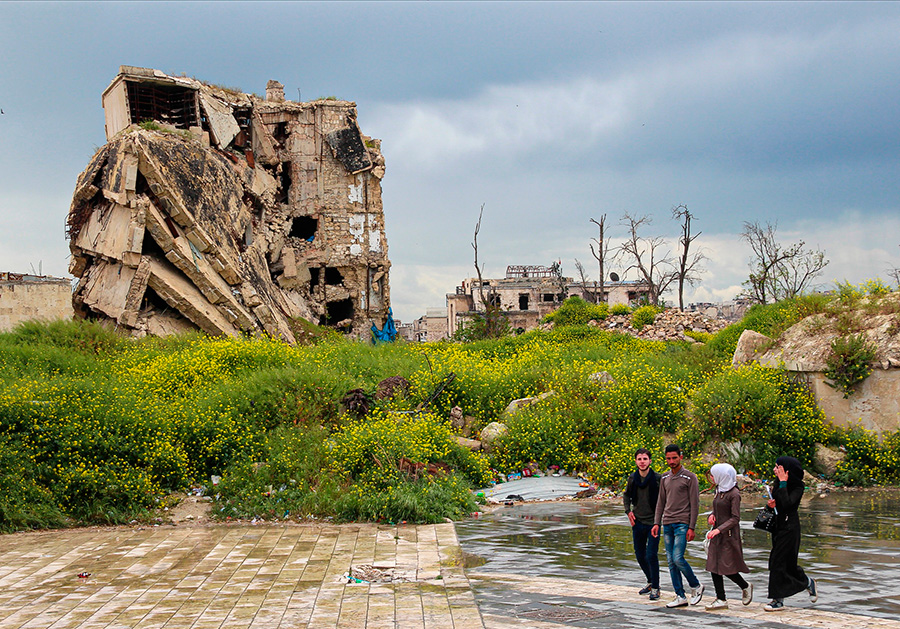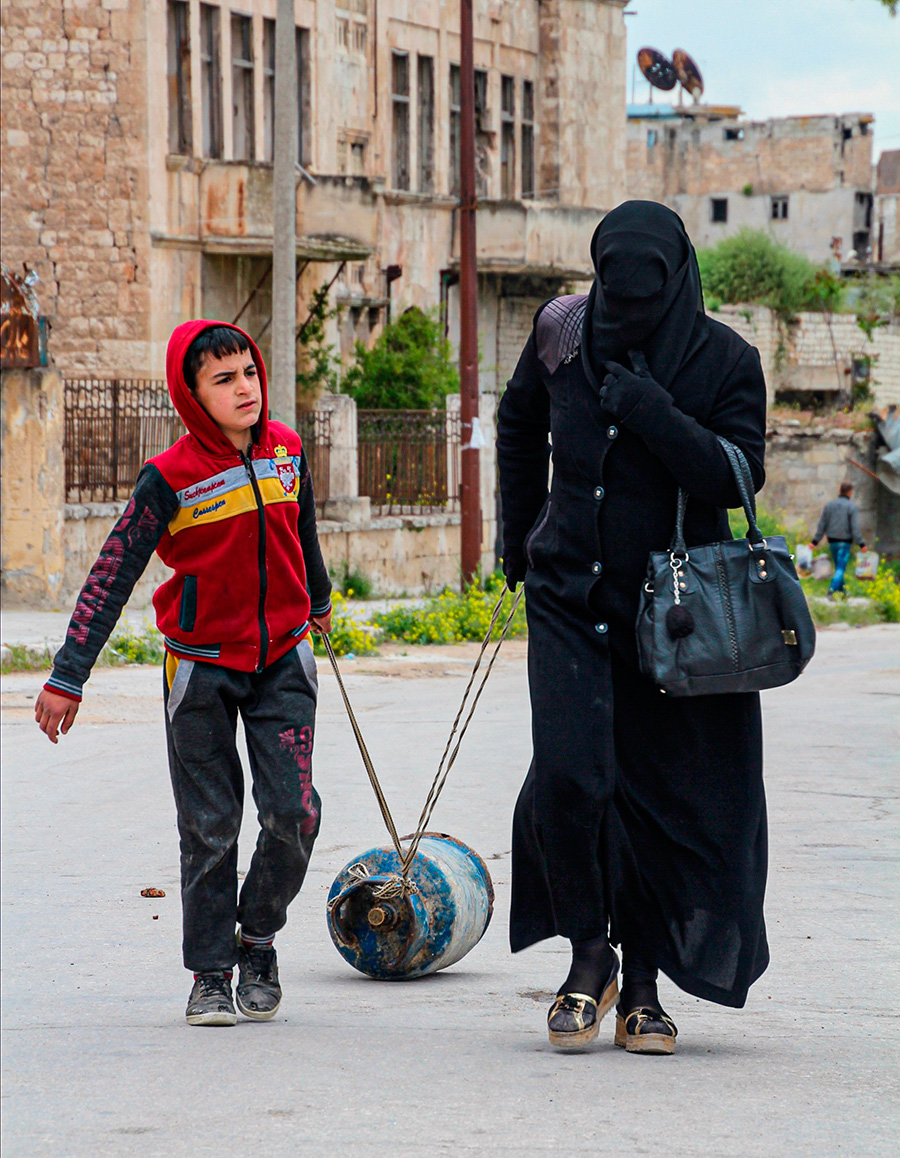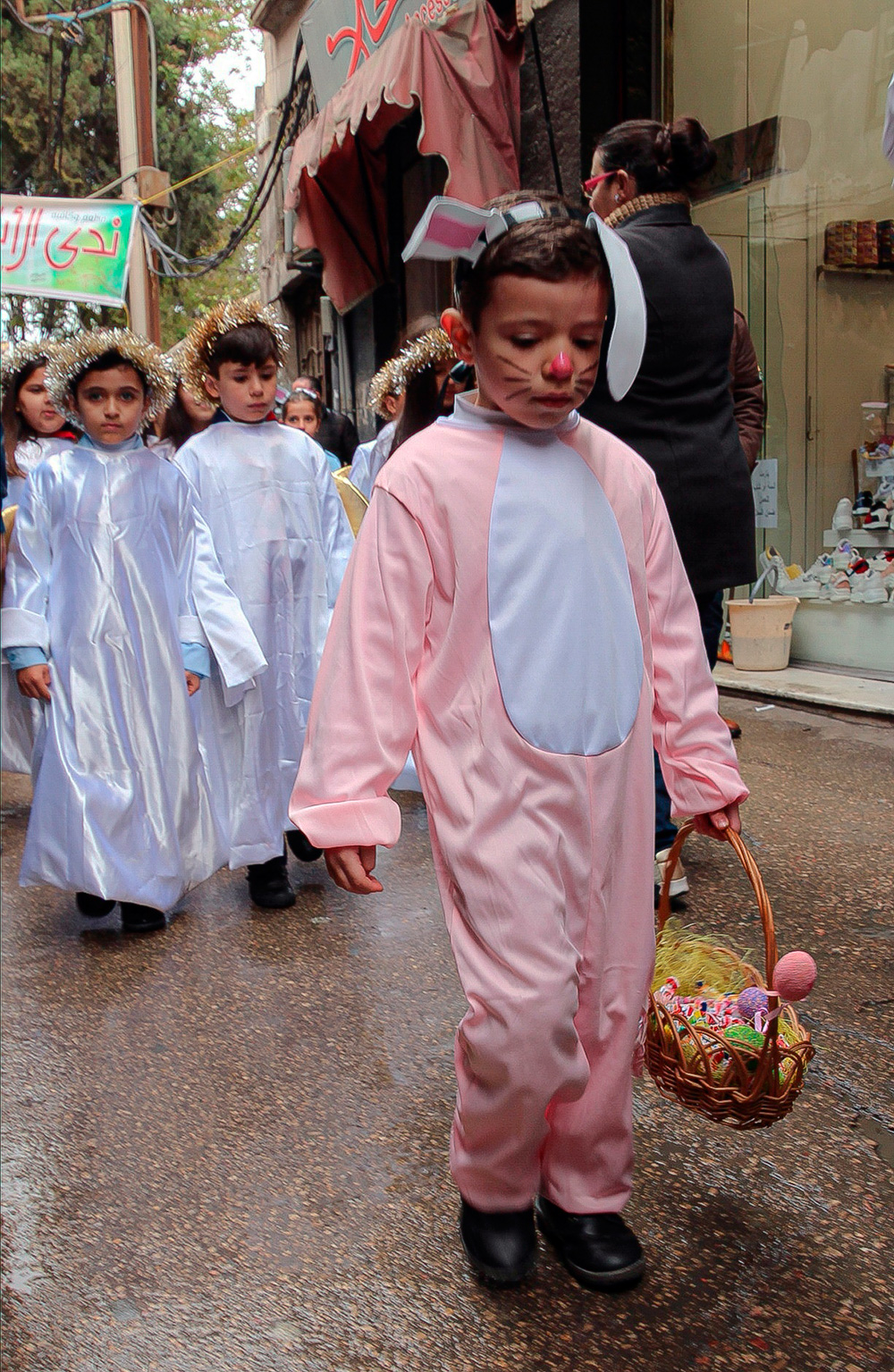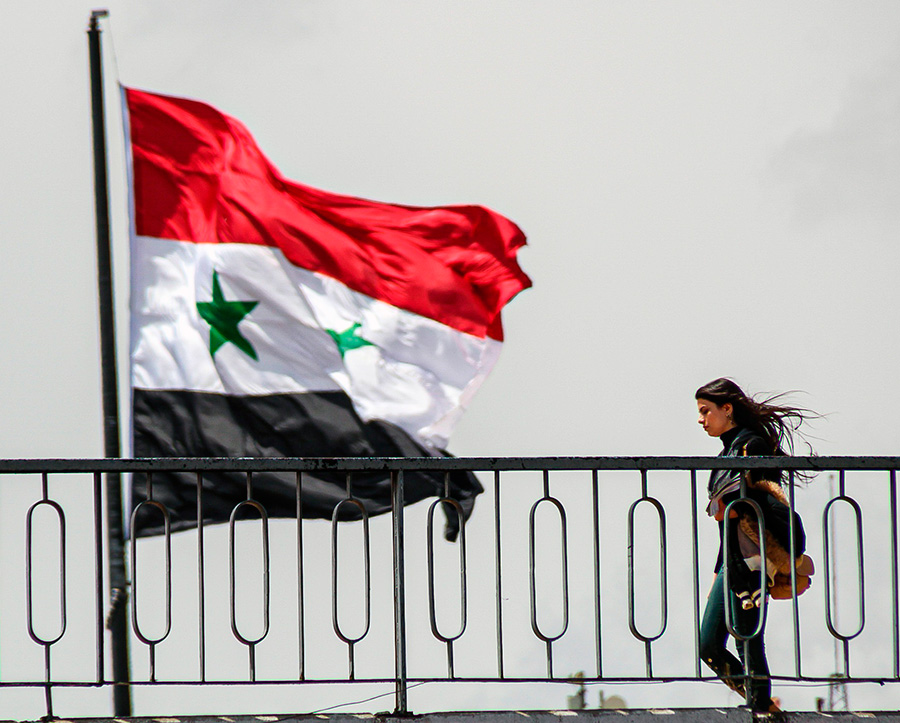 Easter parade in Damascus. fotografija: Slobodan Tomic
Easter parade in Damascus. fotografija: Slobodan Tomic
A mustached border officer in a leather jacket gently drinks his morning coffee under a huge picture of Bashar Al Assad, at the Lebanon-Syrian crossing of Masnaa. A bit suspicious, I hand over my passport and a crumpled piece of paper representing a Syrian visa. I received it via whatsapp just the evening before departure, from Sawsan, who is allegedly working as a local guide, and whose contact I received from another traveler. They point me to another counter to pay the entry fee, and that's it. Three months of visa negotiations and just twenty minutes at the border. I am in a group of 5 other Europeans I have just met, and it seems we are the only foreigners going to Damascus, an hour’s drive from the border. At Crystal Palace Hotel, I am greeted by Sawsan, who will be my guide in the coming days. Recently a German traveler named Felix was arrested for going into the restricted area, so the Syrian Ministry of Tourism decided that all foreigners must be accompanied during their stay in Syria. Accustomed to solo travel, I find it difficult to not be able to move around freely. However, it turned out that the term "guide" was very flexible, and that most of my time there I could spend alone or with the locals.

A boy in Damascus, Syria
Armed only with a smile
The first walk in Damascus took me to the heart of the city, the bazaar Souq Al Hamidiyah. Although my camera has already been triple-checked by the army, which is properly deployed at checkpoints every couple of hundred meters, I did not feel a tinge of tension. The soldiers are armed to the teeth and it is forbidden to photograph them. Although it sounds paradoxical, in reality everything seems casual. The controls are performed at the entrances to parks, shops and major traffic junctions, under the patronage of Bashar Al Assad, whose paintings adorn the facades of all important buildings. Thousands of shops and huge crowds are the everyday life of the largest bazaar in Syria.

Al-Hamidiayah Souq, Damascus, Syria
In just a few minutes the militant streets were replaced by the scent of hookah, jasmine and a variety of spices sold by rather unobtrusive merchants. At the very end of the souq is the exit to the imposing Umayyad Mosque, in front of which proudly stand the remains of the Jupiter Temple, built by the Romans 2,000 years ago.

Temple of Jupiter, Damascus, Syria
In the middle of the mosque is a miracle - the shrine of St. John the Baptist (Yahya) whom Muslims worship as their prophet. Just a few hours walk through the city is enough to experience the cosmopolitan megamix of civilizations whose legacies still remain today. Damascus, after Byblos, is the oldest continuously populated city in the world. As far back as 3,000 BC it was the intersection of the first civilizations, the remains of which I was able to see in the recently opened National History Museum in Damascus. From Mesopotamia and the Assyrians, through the great Babylon to the Greco-Roman period, everyone recognized the strategically important and fertile area of southwestern Syria. The Islamic period and the aftermath of the Ottomans made the majority population today Muslim, with nearly 3 million inhabitants in the greater Damascus region. A few miles south, I reach the Sayyidah Zaynab Mosque. The unbelievably beautiful Persian architecture stands out from the shabby surrounding buildings, and although it has been attacked several times by car bombs, it remains a lure for hordes of local and foreign pilgrims alike.

Sayyidah Zaynab Shiite Mosque, Damascus, Syria
There is no war in Syria
The first thing I learned is that Syrians do not like the word war. The state that the country has been in for the past six years is called crisis, unrest or insurrection, but they do not recognize the state of war. The safe part of Syria is controlled by the army of president Bashar Al Assad, which is under the protection of Russia, Hezbollah and Shiites from Iraq, Iran and Lebanon. The complex military-political situation and the vast amount of information did not give me even a second's respite, as everyone here seems to have their own version of the truth, justice or correlations. In one, though, everyone agrees - ISIS is evil. My plan is to go immediately to Aleppo, the heart of the turmoil and destruction, and leave Damascus for the end.

School children on a field trip in Aleppo, Syria
Although western Aleppo is still under siege by the rebels of the Free Syrian Army (FSA) and Ahrar Al Sham on the one hand and the Kurds on the other, the city is, at least they say so, safe. I took a night bus from Damascus to arrive in the morning, with the ruins of Aleppo looming on the horizon. Dozens of military checkpoints and handing over my passport to strangers were slowly becoming a normal occurrence. At the time of writing, I am still struggling with information such as - where are the Kurds in the Northeast, and how much of the country do they really control? Why do Americans have a Republican army under Trump's leadership, with some of them clinging to Israel and NATO? Who are the rebels of the Islamic State, what do al Qaeda and Al Nusra want? Why are relations with Israel poor, and what is the current state of affairs in the Golan Heights? All these questions would require in-depth analysis and a text twice as long as this, and I'm definitely not a historian or military analyst. The situation is changing day by day, so I prefer to focus on a lot of positive information that we are being denied by today's media.
The rainy weather did not prevent me from going to the Aleppo Citadel, an imposing castle, one of the oldest in the world. Built of limestone in ancient times, it served as a fortress for Romans, Byzantines and Crusaders, until it eventually became part of a UNESCO-protected World Heritage Site.

People dancing in a square in Aleppo, Syria
During the attacks on the city, much of the surrounding area was destroyed and set on fire, however the citadel itself remained incredibly well-preserved and has since been partially reconstructed. Hundreds of children came on a field trip that day, and it was impossible to avoid a million questions and photos. I was a captive audience for the locals, who showed their hospitality in various ways. From interesting questions to song and dance, and even invites to lunch.
Aleppo is still full of life
While touring the Maronite Catholic Church, I meet Mohamad, who is just working on the reconstruction of the collapsed roof and dome. It sounds incredible, but at the same time he is working on the reparation of four churches and two mosques, with his assistant Nour, a young undergraduate in civil engineering. He showed me all the projects he was working on and insisted on taking me to construction sites, which I couldn't refuse. It is amazing that at this point in Aleppo there is more work being done on the reconstruction of Christian buildings than on mosques, and both sides have been severely damaged. Religious divisions do not seem to exist in Aleppo, but Mohamad himself says that at present, reconstruction grants and donations coming from the Christians are more generous.

A street in Aleppo, Syria
Aleppo was a cosmopolitan city, as evidenced by the Hotel Baron, where in room 203 Agatha Christie wrote "Murder in the Orient Express." Its owner Mazloumian took over the hotel after the death of her husband. Now it has been without guests for several years, but people continue to visit for sight-seeing. She gladly welcomed me and with a glass, as she says, of not so good Syrian wine, showed the once famouse hotel that housed Lawrence of Arabia, Charles De Gaulle, Yuri Gagarin, Kemal Ataturk and many others who made this place well-known, until the onset of the conflict and the collapse of tourism. That evening I ended up at Crazy Horse, a club that literally had no patrons except for the owners and a couple of locals. "This was once a lively street. Women walked in short dresses and were full of gold. No one was allowed to touch them – that’s how safe Aleppo was," the owner told me. Today everything closes at dusk, because those who remained in the city aren’t exactly in the mood for night life.
After two days in Aleppo, I realize that our concepts of good and evil are shaped by the media, which are biased and controlled. How many times have you heard that migrants are in fact terrorist units? That Aleppo was flattened, when they broadcast footage of ISIL and al Qaeda triumphantly circling the city's ruins? However, it is true that Aleppo never fell, and that the so-called Islamic State is almost dead. There are only small fragments of it left, mostly around Idlib.

Children practicing karate at Aleppo Citadel, Aleppo, Syria
Watching kids practice karate at the Aleppo Citadel, knowing that their family members had been killed in the last couple of years, at the same time felt euphoric, emotional and devastating, leading me to the brink of a breakdown. It was time to move towards Homs.

Aleppo, Syria
Waiting for the bus on a rainy day, we joked about the thunder because we could hear detonations from the west, but there was no panic. We had to make a detour, given that nearby Idlib is one of the few places still occupied by ISIL, and there is still the possibility of attacks across the surrounding villages.
The temptations at Homs
The red poppy fields stretching from Aleppo to Homs showed me that Dante was right in saying, "The most beautiful flowers are the ones that sprouted from the soil of pain." Over and over again, it seemed to me, from greater suffering and destruction, that an even bigger smile emerged on the faces of children playing hide-and-seek in the citadel or carelessly riding a bicycle around the ruins of a former school. Aleppo definitely shook me, but then what to say about Homs, which hit me straight in the guts? Kilometers of destroyed and burning buildings at the northern entrance to the city quickly shattered my plan to maintain a shield of objective indifference.

Garlic vendors in Homs, Syria
A night stroll on Delicatessen Street meant only one thing: try everything, but you can't pay for anything. Happy to see foreigners in the city, wide-spread hands showered me with a variety of local delicacies, most notably baklava and kadifa. A children's amusement park is open. The contrast between destruction and new life is perfectly evident from the top of the merry-go-round. Something I honestly didn't expect was the crowd of kids on the streets and the variety of fun created seemingly out of nothing. Improvised foosball tables and a game of marbles on the road plowed with craters. Every other boy is Ronaldo or Messi, football is played in the dusty ghetto and those who do not play sell fruit and vegetables. I met a boy who sells only garlic leaning on an old motorcycle. I realized that for me Homs is like an onion, something you slice and chop in tears. However, when you finally taste it, you can't stop, because it acts as a powerful antibiotic for all your "problems". In fact, the worse the area, the kindness and generosity of the locals was more pronounced.

Boys in Homs, Syria
The Kingdom of Heaven is around the corner...
The next leg of my journey takes me to a mountainous area north of Damascus, to the largest Christian shrine in Syria – Maaloula. The monastery is partly carved into the rock in a hilly area 60 km north of Damascus, at an altitude of over 1,500 m. Maaloula is known as one of the last three villages in the world where Aramaic, the language of Jesus Christ, is still spoken. There are also two ancient monasteries in the city: the Catholic Monastery of St. Sarkis and the Greek Orthodox Monastery of Saint Takla. A place of pronounced spiritual energy, but also a war strategic position for many.

A Christian monastery in Maaloula, Syria
A group of 16 nuns at Mar Takla Monastery in Maaloula was taken hostage by terrorists from the Jabhat Al-Nusra (Al Qaeda branch) group in December 2013. They spent three months in captivity and were released in an exchange of prisoners. They don’t want to talk about the turbulent times. The icons still show damaged heads or destroyed mosaics of sacred images. I got their blessing to continue on the road to Damascus, and they wished me a happy Easter, which was the next day.

Easter Day celebration in Damascus, Syria
The all-day Easter program starts from Bab Tuma, a Christian part of Damascus, to cover the entire city with processions and song. The children in angelic uniforms and the orchestra breathed in the true celebratory atmosphere of the largest Christian holiday in the majority Muslim city. Not only was there no tension, but many non-Christians also joined the procession and celebration; a coexistence we do not see in Western capitals boasting with their tolerance and democracy.

Easter Day celebration in Damascus, Syria
I used to go back to the Al Hamidiyah Bazaar every day for three things: first booza, Arabic pistachio ice cream and definitely the best dessert I’ve ever tasted, secondly because of the variety of spices and scents, because you can't leve without buying some jasmine that Damascus is known for, and third , most importantly - because of people. You will hear aboout movie-like destinies at every step of the way, in every conversation longer than five minutes.

Bread vendor in Bab Tuma, Damascus, Syria
I met Peter who was wearing Croatian Defence Council insignia at his shop near the Umayyad Mosque, a taxi driver who worked in Palmyra's oil fields, a Chinese speaking excellent Serbo-Croatian, a Syrian woman whose one daughter is Muslim and the other one Christian, children who don't beg money but just want a moment of attention from a stranger with a camera. When you walk twenty miles through Damascus every day, you can tell that you just barely felt the pulse of the city. The calmness with which taxi drivers wait in huge lines for fuel is fascinating. The country has rich oil reserves, but on the eastern front Americans hold strategic wells and release only as much as they think is sufficient. Waiting can be extended by ten hours, and again, for a dollar or two, you are easily transferred from one part of the city to another.

Damascus, Syria
The sound of generators on the one hand, and the view of solar panels that produce electricity on the other, are constantly forcing you to reconsider your concepts, because contrasts are around every corner. I expected the kids to tug at my sleeve when they saw a stranger with a camera walking around town. I was wrong. Nobody begs, children make a decent living by selling on the street, and always gratefully appreciate your attention no matter whether you buy something or not. Nightlife comes down to going out to local hookah bars in the Bab Tuma area, where with local music or dervish dancing, a relaxing night out sometimes turns into heavy drinking. Young couples walk around hugging or sitting in parks with beer and guitars. The city definitely lives on as if nothing bad is happening, while long guns at every corner warn us that we are in Syria.

A couple next to Umayyad Mosque, Damascus, Syria
On the last day, I was able to go to a football derby game and get a VIP seat in front of a crowded stadium with a fake PRESS ID card that I carry with me on all trips. The Al Jaish football club under the patronage of Bashar Al Assad were able to defeat the visiting Tishreen in an intense game. The guests came with 10,000 fans and left crying because of the defeat, but also because of the tear gas due to the unrests after the game. Still, I didn't feel insecure there either, not even for a second.

Al Jaish vs. Tishreen football game, Damascus, Syria
The final victory of hope
Syria is a beauty within which the beast of conflict and destruction still resides, but that beast has been severly wounded and is now in its death throes. The media continues to broadcast perverted images out into the world, perhaps unwittingly, pushing that same beauty into the abyss, forgetting that Syria is at the same time a warior. And this is not a mere cliché. Syria is a warrior who proudly wears her scars. Syria is the mother of an unbreakable spirit, merciless to those who seek war, open-hearted to those who come in peace.

A girl and a Syrian flag, Damascus, Syria
Syrian hospitality is a rare phenomenon we have a lot to learn from. The apocalyptic scenes disappear in the moment of a child's smile, and death and suffering create a new spiritual dimension of awe I felt for the Syrian people, and gratitude for all the daily blessings I encountered. When the destruction will cease and Syria shine again, even the biggest analysts are unable to answer. Yet, through the lense of ordinary people, you can experience the ring of compassion and euphoria made up of stories full of suffering, struggle, hope and the incredible optimism with which they radiate. To come to Syria with an open heart means to receive a lot more than you can give. Those who dare to go there will realize how poisoned we are by the Western news, and that, in the end, life always wins.

